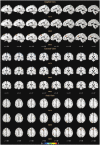Bayesian sparse heritability analysis with high-dimensional neuroimaging phenotypes
- PMID: 32948880
- PMCID: PMC9308456
- DOI: 10.1093/biostatistics/kxaa035
Bayesian sparse heritability analysis with high-dimensional neuroimaging phenotypes
Abstract
Heritability analysis plays a central role in quantitative genetics to describe genetic contribution to human complex traits and prioritize downstream analyses under large-scale phenotypes. Existing works largely focus on modeling single phenotype and currently available multivariate phenotypic methods often suffer from scaling and interpretation. In this article, motivated by understanding how genetic underpinning impacts human brain variation, we develop an integrative Bayesian heritability analysis to jointly estimate heritabilities for high-dimensional neuroimaging traits. To induce sparsity and incorporate brain anatomical configuration, we impose hierarchical selection among both regional and local measurements based on brain structural network and voxel dependence. We also use a nonparametric Dirichlet process mixture model to realize grouping among single nucleotide polymorphism-associated phenotypic variations, providing biological plausibility. Through extensive simulations, we show the proposed method outperforms existing ones in heritability estimation and heritable traits selection under various scenarios. We finally apply the method to two large-scale imaging genetics datasets: the Alzheimer's Disease Neuroimaging Initiative and United Kingdom Biobank and show biologically meaningful results.
Keywords: ADNI; Bayesian hierarchical selection; Dirichlet process; Heritability; Imaging genetics; Ising model; UK Biobank.
© The Author 2020. Published by Oxford University Press. All rights reserved. For permissions, please e-mail: journals.permissions@oup.com.
Figures



Similar articles
-
A Novel Bayesian Semi-parametric Model for Learning Heritable Imaging Traits.Med Image Comput Comput Assist Interv. 2021 Sep-Oct;12905:678-687. doi: 10.1007/978-3-030-87240-3_65. Epub 2021 Sep 21. Med Image Comput Comput Assist Interv. 2021. PMID: 35299630 Free PMC article.
-
A Bayesian group sparse multi-task regression model for imaging genetics.Bioinformatics. 2017 Aug 15;33(16):2513-2522. doi: 10.1093/bioinformatics/btx215. Bioinformatics. 2017. PMID: 28419235 Free PMC article.
-
Structured Genome-Wide Association Studies with Bayesian Hierarchical Variable Selection.Genetics. 2019 Jun;212(2):397-415. doi: 10.1534/genetics.119.301906. Epub 2019 Apr 22. Genetics. 2019. PMID: 31010934 Free PMC article.
-
Identifying Candidate Genetic Associations with MRI-Derived AD-Related ROI via Tree-Guided Sparse Learning.IEEE/ACM Trans Comput Biol Bioinform. 2019 Nov-Dec;16(6):1986-1996. doi: 10.1109/TCBB.2018.2833487. Epub 2018 May 7. IEEE/ACM Trans Comput Biol Bioinform. 2019. PMID: 29993890 Free PMC article.
-
Detecting genetic associations with brain imaging phenotypes in Alzheimer's disease via a novel structured KCCA approach.J Bioinform Comput Biol. 2021 Aug;19(4):2150012. doi: 10.1142/S0219720021500128. Epub 2021 May 4. J Bioinform Comput Biol. 2021. PMID: 33950804
Cited by
-
Bayesian subtyping for multi-state brain functional connectome with application on preadolescent brain cognition.Biostatistics. 2024 Dec 31;26(1):kxae045. doi: 10.1093/biostatistics/kxae045. Biostatistics. 2024. PMID: 39656842
-
Neuroimaging techniques, gene therapy, and gut microbiota: frontier advances and integrated applications in Alzheimer's Disease research.Front Aging Neurosci. 2024 Dec 3;16:1485657. doi: 10.3389/fnagi.2024.1485657. eCollection 2024. Front Aging Neurosci. 2024. PMID: 39691161 Free PMC article. Review.
-
Bayesian mixed model inference for genetic association under related samples with brain network phenotype.Biostatistics. 2024 Oct 1;25(4):1195-1209. doi: 10.1093/biostatistics/kxae008. Biostatistics. 2024. PMID: 38494649 Free PMC article.
-
A Novel Bayesian Semi-parametric Model for Learning Heritable Imaging Traits.Med Image Comput Comput Assist Interv. 2021 Sep-Oct;12905:678-687. doi: 10.1007/978-3-030-87240-3_65. Epub 2021 Sep 21. Med Image Comput Comput Assist Interv. 2021. PMID: 35299630 Free PMC article.
-
Heritability estimation of subcortical volumes in a multi-ethnic multi-site cohort study.bioRxiv [Preprint]. 2024 Jan 12:2024.01.11.575231. doi: 10.1101/2024.01.11.575231. bioRxiv. 2024. PMID: 38260520 Free PMC article. Preprint.
References
-
- Blokland, G. A. M., McMahon K. L., Hoffman J., Zhu G., Meredith M., Martin N. G., Thompson P. M., De Zubicaray, G. I. and Wright M. J. (2008). Quantifying the heritability of task-related brain activation and performance during the n-back working memory task: a twin fMRI study. Biological Psychology 79, 70–79. - PMC - PubMed
-
- Chen, R.-B., Chu C.-H., Yuan S. and Wu Y. N. (2016). Bayesian sparse group selection. Journal of Computational and Graphical Statistics 25, 665–683.
Publication types
MeSH terms
Grants and funding
LinkOut - more resources
Full Text Sources
Medical

